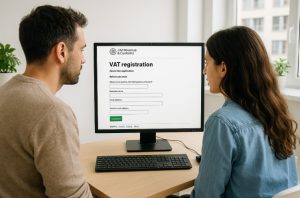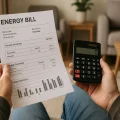Last Updated on: 2nd August 2025, 10:25 am
Are you running a business in the UK and wondering when VAT registration becomes necessary? If your turnover is increasing or you’re planning future sales expansion, understanding VAT obligations is crucial to remain compliant with HMRC.
VAT (Value Added Tax) plays a significant role in how businesses collect and report taxes, and missing the right registration window can lead to penalties. Whether you’re self-employed, running a limited company, or operating overseas while selling into the UK, recognising the exact moment to register for VAT will protect your business from financial and legal setbacks.
This blog will walk you through every key aspect of VAT registration, from mandatory thresholds and voluntary registration options to late penalties and how to cancel or transfer VAT registrations. By the end of this guide, you’ll be well-equipped to make informed decisions about when and how to register for VAT in the UK.
What Is VAT and How Does It Work in the UK?

VAT, or Value Added Tax, is a consumption tax applied to the sale of most goods and services in the UK. Businesses collect VAT on behalf of HMRC, charging customers VAT on sales while reclaiming VAT they pay on eligible business purchases.
There are three standard VAT rates:
| VAT Rate | Percentage | Examples of Applicable Items |
|---|---|---|
| Standard Rate | 20% | Most goods and services |
| Reduced Rate | 5% | Children’s car seats, home energy |
| Zero Rate | 0% | Books, children’s clothes, exports |
As a VAT-registered business, you’re responsible for:
- Including VAT in prices
- Keeping accurate VAT records
- Filing regular VAT returns, usually quarterly
- Paying HMRC the net VAT owed
You must also apply the correct VAT rate depending on the goods or services provided and their classification under HMRC guidance. If you sell exempt or ‘out of scope’ items, such as financial services or education, you may not need to charge VAT at all.
Once registered, you gain a VAT number and must include it on invoices and receipts. Understanding how VAT works is essential to managing finances and remaining compliant with tax regulations in the UK.
What Is the VAT Registration Threshold for 2025?
For the 2025 tax year, the VAT registration threshold in the UK remains at £90,000. If your taxable turnover exceeds this figure in a 12-month period, you’re legally required to register for VAT. Taxable turnover includes the value of all goods and services you supply that are not VAT exempt.
This can consist of:
- Standard, reduced, and zero-rated goods
- Goods hired or loaned to customers
- Business goods used for personal purposes
- Services received from overseas suppliers where a reverse charge applies
If you anticipate your turnover will go over £90,000 within the next 30 days, registration is still required, even if you haven’t hit the threshold yet.
This rule ensures businesses don’t delay registration until after significant deals or contracts. Those dealing with acquisitions from the EU into Northern Ireland must also register if the total exceeds £90,000.
It’s important to monitor turnover regularly and calculate whether you’re approaching or exceeding the threshold. Staying ahead of these thresholds helps avoid penalties and ensures you’re collecting VAT legally and efficiently.
When Must You Register for VAT Based on Turnover?
You must register for VAT when your total taxable turnover exceeds £90,000 in the past 12 months or if you expect it to do so within the next 30 days. Timing is critical here. HMRC gives you a limited window to register once the threshold is crossed.
Key triggers for VAT registration:
- Your 12-month rolling taxable turnover exceeds £90,000
- You sign a contract or receive an order that will push turnover above £90,000 in the next 30 days
- You acquire an existing VAT-registered business which causes your combined turnover to exceed the threshold
You must apply within 30 days of the end of the month when you exceed the threshold. Your effective registration date is the first day of the second month after breaching the limit.
| Scenario | Date of Turnover Breach | VAT Registration Deadline | Effective Registration Date |
| Cumulative turnover hits £100,000 | 15 July | 30 August | 1 September |
| £100,000 contract signed | 1 May | 30 May | 1 May |
By staying proactive and tracking your monthly turnover, you’ll be able to determine when you’re approaching the threshold and take timely action.
Can You Register for VAT Voluntarily?

Yes, even if your business turnover is below £90,000, you may choose to register for VAT voluntarily. This option can offer several benefits depending on your operations and client base.
Voluntary registration allows you to:
- Reclaim VAT on business expenses
- Add professionalism and credibility to your brand
- Simplify international trade, especially within the EU
- Appeal to VAT-registered customers who can reclaim the VAT you charge
Voluntary registration is particularly useful if you:
- Expect to go over the threshold soon
- Work with other VAT-registered businesses
- Have high start-up costs with reclaimable VAT
Once registered, you’re subject to the same rules as mandatory registrants, including VAT returns and accurate record-keeping.
It’s worth speaking to an accountant or tax adviser before registering voluntarily to weigh up the administrative load versus the financial benefits. Voluntary VAT registration can be strategic for scaling businesses and those in B2B industries.
What Happens If You Register for VAT Late?
If you fail to register for VAT within the required timeframe, HMRC may impose financial penalties and require you to backdate VAT payments. This includes charging VAT on sales from the date you should have registered.
Consequences of late VAT registration include:
- Paying owed VAT on all taxable sales from the effective date
- Penalty fines depending on the delay and amount owed
- Reputational damage and additional admin work
For example, if you should have registered on 1 July but delayed until 1 October, you’ll need to account for VAT from July and may owe three months’ VAT plus interest.
HMRC determines penalties based on how late the registration is and the size of unpaid VAT. Ignorance is not considered a valid excuse, though exceptions are sometimes granted for temporary threshold breaches or administrative errors. To avoid penalties, monitor your turnover closely and act immediately if it looks like you’ll exceed the threshold.
How Do You Register for VAT with HMRC?

Registering for VAT with HMRC involves an online process that varies slightly depending on your business structure. Here’s everything you need to know to complete it successfully.
Step-by-step VAT Registration Process
- Go to the HMRC VAT registration portal
- Sign in with your Government Gateway ID or create one
- Provide business and personal details
- Enter your taxable turnover estimate
- Choose your accounting scheme (e.g., standard, flat rate)
- Submit and wait for confirmation
You’ll receive a 9-digit VAT number and your effective date of registration once approved.
Required Documents for Companies, Individuals, and Partnerships
For a limited company:
- Company registration number
- Business bank details
- Unique Taxpayer Reference (UTR)
- Projected 12-month turnover
For individuals/partnerships:
- National Insurance number
- Proof of ID (passport or driving licence)
- UTR if available
- Income details and forecast
Registering Online vs by Post
You can register online in most cases, but certain businesses must register via post using form VAT1, including:
- Agricultural Flat Rate Scheme members
- Businesses registering as part of a VAT group
- Overseas businesses with UK activities
Government Gateway access
To use the online VAT service, you need a Government Gateway account. If you don’t have one, you can create it during registration. This account will allow you to file VAT returns, update business details, and monitor correspondence with HMRC.
Once registered, you’ll receive all documents, VAT numbers, and guidance by post. If you’re using an agent, they can handle the entire registration and filing process for you.
Getting registered correctly is essential for avoiding future tax complications and ensuring that you can legally charge VAT from the effective date.
What Should You Do While Waiting for Your VAT Number?

After submitting your application, you’ll need to wait for HMRC to issue your VAT number before including VAT on your invoices. However, you can still raise VAT-inclusive invoices by adjusting your pricing.
While waiting, you can:
- Increase invoice amounts to account for future VAT
- Notify customers that VAT will be charged retrospectively
- Reissue invoices with VAT details once your number is received
For example, if you issue a £100,000 invoice before receiving your number, you can add 20 percent VAT now and later reissue the invoice with VAT properly documented.
Your client will then be able to reclaim the VAT once they have the corrected invoice. Stay organised during this interim period, and ensure all records are updated when your registration is confirmed.
How Do You Change or Update Your VAT Registration Details?
Keeping your VAT registration information up to date is a legal requirement. If any of your business circumstances change, you must inform HMRC within 30 days to avoid possible penalties.
Common updates include:
- Changing your trading name or business address
- Adding or removing partners in a partnership
- Switching agents or accountants
- Updating repayment bank account details
- Changing VAT return filing frequency
You can update most of your information through your VAT online account. For changes such as business structure or legal entity, you may need to complete additional forms like VAT2 (for partnerships) or VAT68 (for registration transfers).
If you’re unable to use the online account, you must contact HMRC by phone or post to ensure the details are updated manually. Always retain confirmation of submitted changes for your records.
Maintaining accurate VAT registration details ensures smooth communication with HMRC and helps you stay compliant at all times.
When Should You Cancel Your VAT Registration?

You may need to cancel your VAT registration when your business no longer meets the requirements or your operations change significantly. Cancellation is essential to avoid unnecessary VAT filings and to stay compliant with HMRC rules.
Circumstances When Cancellation is Required
You must cancel your VAT registration if:
- You stop trading or supplying taxable goods or services
- You join a VAT group
- Your taxable turnover falls below £88,000, and you wish to deregister
You can request voluntary cancellation if most or all of your supplies are zero-rated, but HMRC approval is required.
How to Cancel Online and via Post?
Cancel online if:
- You have a Government Gateway account
- You’re not part of a VAT group
- Your turnover falls below the threshold
To cancel by post, complete form VAT7 and mail it to HMRC.
This is necessary if:
- Your business structure has changed
- You’ve sold your business
- You’re closing a VAT group
Make sure all parts of the form are completed. HMRC typically confirms cancellations within three weeks.
What Happens After VAT Deregistration?
After cancellation:
- Stop charging VAT from the effective date
- Submit your final VAT return
- Account for stock or assets worth over £1,000 if you reclaimed VAT on them
- Keep VAT records for at least six years
| Reason for Cancellation | Method | Action Needed |
| Stopped trading | Online | Submit VAT return, close account |
| Business sold | Post (VAT7) | Notify HMRC, cancel VAT, pass records to buyer |
| Turnover < £88,000 | Online or Post | Apply for cancellation |
Proper cancellation ensures you avoid unnecessary filings and stay aligned with VAT rules after business changes.
Can You Transfer a VAT Registration Number?

Yes, you can transfer a VAT registration number if your business changes ownership or legal status. This allows continuity in VAT records and simplifies client invoicing and record-keeping.
You may transfer the VAT number if:
- You take over a business
- A partnership changes into a sole trader
- A company merges or is acquired
Both the buyer and seller (or old and new legal entity) must complete form VAT68, and the new owner must also register for VAT in their new status.
If you prefer a new VAT number, cancel the old registration and apply for a fresh one. Just remember, transferring also means transferring any associated VAT obligations and historical liabilities. Maintaining the same VAT number is often easier when continuity of clients, suppliers, or contracts is important.
Do You Need to Register for VAT in EU Countries or Northern Ireland?
If your business involves goods or services moving between the UK and the EU or Northern Ireland, you may need additional VAT registrations, depending on your sales volume and location.
Northern Ireland Protocol rules apply if:
- Your goods are located in Northern Ireland when sold
- You sell or move goods from Northern Ireland to the EU
- You receive goods from VAT-registered EU businesses into Northern Ireland
If you’re selling over £8,818 in goods annually to EU customers from Northern Ireland, you must register for VAT in those EU countries or use the VAT One Stop Shop (OSS).
Services provided from the UK to EU customers may require registration under the non-union VAT OSS, especially for digital services.
For exports from Great Britain (England, Wales, Scotland) to the EU, you can zero-rate VAT but must retain valid evidence of export. Keeping up with these rules helps you avoid unexpected tax obligations abroad.
What VAT Schemes Could Simplify Your Accounting?
HMRC offers various VAT schemes designed to ease reporting for small and medium-sized businesses. Choosing the right scheme can streamline accounting and cash flow.
- VAT Flat Rate Scheme: Pay a fixed percentage based on your industry. Available if your turnover is under £150,000. No need to track VAT on every purchase.
- Cash Accounting Scheme: You pay VAT to HMRC only when you receive payments from customers. Ideal for businesses with late-paying clients.
- Annual Accounting Scheme: Submit one VAT return per year instead of four. Best for businesses with steady income.
- Retail and margin schemes: Designed for second-hand goods and retail businesses, these help calculate VAT on the margin or simplify sales tracking.
| VAT Scheme | Join Threshold | Leave Threshold |
| Flat Rate | £150,000 | £230,000 |
| Cash Accounting | £1.35 million | £1.6 million |
| Annual Accounting | £1.35 million | £1.6 million |
Choosing a scheme depends on your turnover, business type, and cash flow preferences.
Conclusion
VAT registration in the UK is a crucial step for growing businesses. Knowing exactly when to register, what documents you need, and how to stay compliant helps you avoid costly penalties and enhances your business’s professional image.
Whether you’re registering due to mandatory turnover thresholds or making a strategic voluntary choice, it’s essential to follow the correct procedures and deadlines.
With guidance from official HMRC sources and a clear understanding of VAT schemes, exemptions, and registration methods, you’re better positioned to manage your VAT obligations smoothly. Stay informed, track your sales, and take action early. That’s the best way to stay ahead.
FAQs
What is the current VAT registration threshold in the UK?
The current threshold for VAT registration in the UK is £90,000 in taxable turnover over the past 12 months.
How do I know if my business turnover exceeds the VAT threshold?
Monitor your rolling 12-month turnover and include all taxable supplies that are not VAT exempt.
Can I register for VAT even if I earn below the threshold?
Yes, voluntary VAT registration is available and can be beneficial for reclaiming input VAT.
What happens if I delay VAT registration?
You’ll need to pay VAT from the date you should have registered and may face penalties.
Do overseas businesses need to register for VAT in the UK?
Yes, if they supply taxable goods or services to UK customers, registration may be required.
How long does it take to get a VAT number after applying?
Usually, you’ll receive your VAT number within 2 to 4 weeks of submitting your application.
Can I reclaim VAT for purchases made before registration?
Yes, VAT on goods bought up to 4 years before registration and services within 6 months can be reclaimed.




















No Comments
Leave a comment Cancel